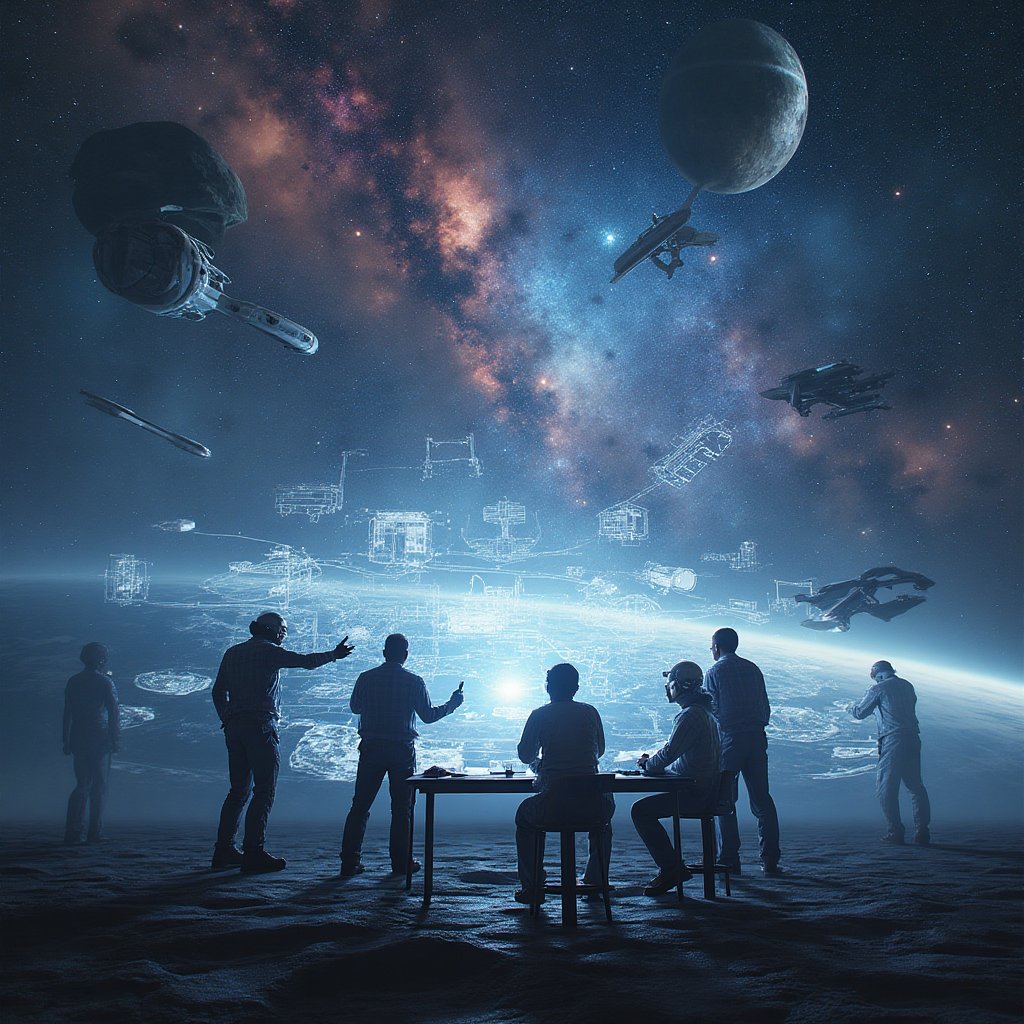Introduction: The Cosmos Awaits
The universe is under no obligation to make sense to you. – Neil deGrasse Tyson.
Which, if you ask me, kind of explains cosmic complexity. It resonates with our quest to tame interstellar wilds with AI as our compass. In the vast ocean of space, who will brave the cosmic seas to design paths that ensure humanity thrives beyond Earth? As we stand on the cusp of this bold future, Artificial Intelligence (AI) emerges as our guiding force in crafting galactic infrastructures. Picture it: AI crafting the blueprints of tomorrow’s space highways, much like visionary scribes like Arthur C. Clarke and Isaac Asimov imagined. The idea of interstellar travel tickles our imagination, but it’s the logistics that define the journey. Now, let us delve into how AI could forge the bridges of the galaxy, echoing the ambitions once sketched by Elon Musk and others.
The Necessity of Galactic Trade Routes
From the ancient Silk Road to bustling maritime paths, trade routes pulsated as lifelines of human advancement. With eyes set upon the cosmic horizon, what if the stars themselves hold the key to prosperity? Establishing efficient and secure routes is not just a choice; it’s an interstellar imperative.
Historical Context of Trade Routes
Take a moment to marinate in the ancient wisdom of trade routes. Think of the enduring legacy of the Silk Road, or the persistent hum of maritime commerce. They weren’t just pathways; they were vibrant veins pumping life into civilizations. Bringing this concept to the cosmos, imagining space trade mimicking earthly routes, is nothing short of epic. As civilization expands outward, the lessons from the Silk Road, lovingly detailed by historians like Valerie Hansen, provide a stellar map. It’s about seeing the stars not merely as points of light, but as nodes in an economic network.
The Economic Imperative
If planets could talk, imagine the tales they'd tell of untapped riches. The cosmos isn’t just a backdrop; it’s a bustling marketplace waiting to unfold. Minerals, energy resources, and maybe elements unknown could be part of interstellar trade, fueling a galactic economy. Picture mankind’s ventures along the Milky Way akin to historical exploration quests, only these sights are set on moon minerals and Martian metals. The economic incentives echo the ambitions of past explorers yet herald new possibilities. Voices like Elon Musk and their insights into space economies are no longer confined to dreams.
Designing Sustainable Habitats for Space Inhabitants
Space—which isn't just a final frontier, but a final "real estate" market too. If Mars were on Zillow, we'd swipe right! Yet cool as it sounds, creating sustainable habitats out there is no cakewalk. This monumental task requires more than just enthusiasm; it calls for a fusion of cutting-edge technology and a deep understanding of human needs. Let's dig into the nitty-gritty.
Environmental Considerations
First, let's talk about the elephant in the room—or rather, the vacuum in the cosmos. Designing habitats in space means tackling a host of environmental challenges. Whether it's the dusty plains of Mars, the rocky wilderness of the Moon, or simply lonely asteroids floating around, diverse celestial bodies demand tailor-made solutions.
It's like redecorating at extremes where gravity's more a suggestion than a rule. In these environments, NASA and ESA are already making headway, with technology for everything from oxygen production to meteorite shielding looking more sci-fi every day.
Psychological Factors in Habitat Design
Designing a habitat that doesn't turn into a psychological thriller is just as crucial as beating the physical elements. Imagine being in a tiny box in space for months on end. Cabin fever? More like space station fever!
The goal is to create an environment promoting mental well-being and community building. We must focus on social structures, virtual reality options (goodbye, terrestrial boredom!), and mental health supports in these otherworldly homes.
Let's face it: human needs don't just stop with air and water. They extend to mental stimulation, happiness, and the occasional space dance party with colleagues.
AI in Navigation and Route Optimization
When it comes to navigating the cosmos, size really does matter. The universe isn't as straightforward as a Sunday drive. Enter AI: our trusted co-pilot guiding us through literal star maps and black-hole potholes.
The Role of Machine Learning in Navigation
AI's magical power? Processing a galaxy of data! Machine learning refines navigation methods with each interstellar trip. It's the ultimate upgrade to GPS—think interplanetary rather than just interstate.
With AI, spaceships can now be equipped to adapt to new cosmic terrains and unforeseen phenomena. It's like upgrading from a compass to Google Maps, but with a splash of stardust! Plus, as cosmic cartography emerges, computing wonders like OpenAI and similar pals push into the frontier of this uncharted territory.
Algorithm Design for Route Safety
AI isn't only about sounding smart; it's about being smart. That means ensuring routes are safe. Algorithms tirelessly analyze every detail, balancing safety and time efficiency in interstellar travel.
In essence, we're teaching these systems to discern between the best galactic expressways and potential cosmic calamities. Think of it as building a safety net woven from logic, data, and dispassionate silicon brains ready to prioritize crew safety above all.
This AI wizardry doesn't just redefine space travel; it reimagines it safely, efficiently, and—just maybe—with a sprinkle of pizzazz.
The Ethics of AI in Space Exploration
As we step into uncharted territories with AI steering our cosmic ships, we can't ignore the moral compass guiding us through these vast expanses. The integration of AI in space exploration might seem like an astronomical leap, but it also invites a constellation of ethical quandaries. How do we ensure that machines making decisions amidst the stars reflect the values we hold dear on Earth? The dance between autonomy and oversight is delicate, and humanity must choreograph it with care.
Autonomy vs. Human Oversight
The debate of autonomy versus oversight is akin to placing faith in your GPS to guide you through a dense fog. Do we trust AI to navigate the unknown without human intervention? NASA and other space agencies are grappling with just how independent AI should be when making critical decisions in the dark vacuum of space.
One remarkable aspect of AI is its ability to make decisions faster than a human ever could. However, when the situation turns critical, like a malfunction aboard a space station, should AI obligingly ask for human confirmation, or is autonomy the ticket? Think of it this way: a chess master may foresee ten moves ahead, but does he still consult the board when the stakes skyrocket? The same question echoes in the corridors of interstellar governance.
Ethical Implications of Life and Death Decisions
Imagine AI aboard a colony ship faced with a life support decision. What parameters will it balance? The ethical burden of life and death decisions weighs heavily. Consider OpenAI's exploration into AI decision-making — their studies can help us ponder these weighty scenarios.
- Life support priority: AI must decide resource allocation for crew survival.
- Resource management: Will AI favor efficiency over empathy?
- Decision override: What protocols enable human intervention if AI’s choices teeter on the precipice of ethics?
These are the ethical threads we must weave thoughtfully into the fabric of AI space exploration, shaping a future where machines reflect our highest ideals while venturing where humans dare to dream.
Collaboration Between AI and Human Expertise
In the expansive theater of space exploration, AI and human collaboration is the star performance. A celestial partnership driven by shared expertise and vision is not only vital but invigorating. As we embark on cosmic conquests, the age-old adage of “two heads are better than one” feels truer when one of those heads is an AI that can crunch numbers faster than a speeding meteor.
Building Interdisciplinary Teams
Constructing an interdisciplinary team is akin to weaving a tapestry of diverse brilliance — with AI as the ever-evolving thread. Expertise from fields like engineering, biology, and space architecture becomes crucial. MIT's initiatives in collaborative innovation showcase how diverse minds can harmonize with AI systems.
Successful interdisciplinary teams engage:
- AI Experts: Masters of algorithms and machine learning, they ensure AI systems develop responsibly.
- Engineers: These wizards of construction lay the bricks of new space habitats.
- Biologists: They ensure sustainability, hypothesizing life support systems for extraterrestrial living.
- Ethicists: Guardians of morality, they ponder the consequences of AI’s cosmic autonomy.
Overcoming Challenges in Collaboration
Cross-discipline collaboration isn’t without turbulence, but much like finding your footing in zero gravity, it’s essential for voyages into the unknown. Challenges often linger in:
- Communication: Bridging jargon-heavy divides between tech-savvy AI experts and intuitive biologists necessitates a Rosetta Stone-like approach.
- Resource allocation: Harmonizing different priorities from varying experts requires adept leadership akin to a maestro in a space symphony.
Tackling these hurdles means forging a culture of structured synergy — the blend of human creativity with AI’s relentless logic, heralding innovations that echo through the cosmos.
AI Solutions: How Would AI Tackle This Issue?
If you were an AI, how would you methodically tackle the complexities involved in AI space architecture? Here's a structured approach that could guide institutions, organizations, and governments as they navigate the uncharted waters of interstellar exploration.
Step 1: Data Collection and Analysis on Current Astrophysical Research
First, gather data from various space agencies such as NASA, the European Space Agency (ESA), and research institutions focusing on astrophysics. Utilize big data analytics to collect findings on celestial bodies, gravity wells, resource availability, and general environmental conditions.
Step 2: Algorithm Development to Simulate Trade Routes and Habitats
Design and test algorithms that can model various scenarios, taking into account variables such as gravitational forces, speed, and celestial navigation dynamics. These simulations would rely heavily on AI technologies from leaders in machine learning like Google and IBM's Watson. Collaboration with universities like the Massachusetts Institute of Technology (MIT) could provide cutting-edge research to bolster these models.
Step 3: Integration of Machine Learning for Adaptive Systems
Implement machine learning to create adaptive systems that evolve as new data comes in. This would facilitate real-time updates to everything from navigation systems to habitat conditions based on learned experiences from previous missions. Consider partnerships with platforms like Microsoft Research for developing robust, resilient AI systems.
Step 4: Continuous Monitoring and Feedback Mechanism for Optimization
Once AI systems are in place, set up a continuous monitoring and feedback loop to gather data from space missions. This will refine algorithms and help predict future challenges. Implementing cloud-based solutions, such as those offered by Amazon Web Services (AWS), can facilitate global data sharing and collaboration across different international teams.
To put these strategies into action, here’s a carefully structured **Roadmap** spanning from Day 1 to Year 2:
Actions Schedule/Roadmap (Day 1 to Year 2)
Day 1
Kick off with a project meeting that gathers stakeholders, including scientists, AI experts, and ethicists. Define core objectives, scope, and roles.
Week 1
Establish a core interdisciplinary team; this group should include AI specialists, aerospace engineers from organizations like SpaceX, and biologists familiar with sustainability in closed environments.
Month 1
Conduct an extensive literature review using databases like ScienceDirect to gather data on celestial and interstellar resources.
Month 3
Begin deploying preliminary simulations using AI tools to model the trade routes around the solar system, focusing on safety, efficiency, and resource availability.
Year 1
Work on developing design systems for sustainable habitats. Engage with organizations like NAIOP to integrate best practices in sustainable design. Unify efforts across international teams for a cohesive vision.
Year 1.5
Evaluate progress on route optimization and habitat sustainability. Conduct peer reviews with experts from organizations like NOAA and initiate public engagement efforts.
Year 2
Present the project findings to stakeholders and the public. Use platforms such as TED Talks for spiritual and communal outreach. Discuss next phases and future directions, engaging in dialogue with the academic community to inspire further innovation.
Conclusion: The Road Ahead
As we embark on the incredible journey into the cosmos, the union of AI and human ingenuity holds the promise of illuminating our path. Together, we can design more than just trade routes and habitats — we can redefine the human narrative as we set foot on new worlds. Believe it or not, we are on the brink of a cosmic renaissance that may well become the ultimate testament to our capacity for adaptation and innovation. Imagine the possible wonders as we forge relationships with other celestial bodies and their potential inhabitants! The era of galactic trade stands upon the shoulders of collaboration, ethical considerations, and above all, an unyielding human spirit. So, let's prepare ourselves for an unprecedented adventure across the stars, writing the next chapters not just for our civilization, but for the entire tapestry of existence.
FAQ
What is the main role of AI in space architecture?
The main role of AI in space architecture is to help plan, design, and manage space habitats and trade routes. AI can analyze large amounts of data, which is super important for navigating the complex and vast universe. By processing this information, AI can suggest the best locations for habitats and create safe paths for interstellar travel.
How might AI impact trade in space?
AI can significantly change how trade works in space. Here's how:
- Route Planning: AI can figure out the safest and most efficient routes for spacecraft to travel between planets.
- Resource Mapping: AI can help find valuable resources on other planets and asteroids, making trade more lucrative.
- Real-Time Decisions: AI can adapt to unexpected events in space and find new options for trade on the fly.
Are there ethical concerns with AI in space exploration?
Yes, there are many ethical concerns. AI might make decisions that impact human lives in space habitats. Key issues include:
- Autonomy vs. Human Control: How much decision-making should AI handle without human input?
- Life and Death Decisions: Could AI be trusted to manage life support and resources wisely?
- Privacy and Security: How do we ensure that AI protects the data of people living in space?
What kind of skills do experts need to work with AI in space?
Working with AI in space requires a mix of skills. People need to be good at things like:
- Engineering: Designing space habitats that can support life.
- Data Science: Understanding the data that AI analyzes and learns from.
- Environmental Psychology: Knowing how to design spaces that promote mental well-being.
- Ethics: Making sure that AI makes good choices and respects human lives.
How long will it take to create trade routes in space?
The timeline is not clear. However, experts believe that with the right investments and research breakthroughs, we could see early trade routes established within the next 20 years. The pace of progress will rely on collaboration between organizations like NASA, the European Space Agency (ESA), and private companies pushing the boundaries of space exploration.
Can AI help us find new planets for habitation?
Absolutely! AI can analyze data from telescopes and space missions to identify planets that resemble Earth. By using advanced algorithms, it can evaluate factors like atmosphere, distance from their sun, and potential resources. Scientists and organizations like NASA's Exoplanet Exploration are already using AI to discover new worlds beyond our solar system.
What are some challenges in using AI for space architecture?
AI can help a lot, but there are also some challenges:
- Data Limitations: AI needs accurate data to make good decisions. If data is missing or wrong, it might lead to issues.
- Complex Environments: Space conditions change quickly, and AI must be adaptable to handle these changes.
- Human Factors: Making sure humans and AI can work together effectively is essential for mission success.
Will AI be more reliable than humans in space missions?
AI can process information quickly and make decisions based on data, which can sometimes be faster than human judgment. However, human intuition and experience are irreplaceable. This suggests that the best approach is to combine the strengths of both AI and humans for the safest and most efficient space missions.
How do we ensure AI systems stay safe in space?
Keeping AI systems safe in space involves strict testing and monitoring. This means:
- Robust Design: Building AI with safeguards against failures and unexpected events.
- Regular Updates: Continuously updating AI systems based on new discoveries and challenges.
- Clear Protocols: Establishing rules on how AI should react in different situations.
Wait! There's more...check out our gripping short story that continues the journey: The Colors We Wear
Disclaimer: This article may contain affiliate links. If you click on these links and make a purchase, we may receive a commission at no additional cost to you. Our recommendations and reviews are always independent and objective, aiming to provide you with the best information and resources.
Get Exclusive Stories, Photos, Art & Offers - Subscribe Today!





























Post Comment
You must be logged in to post a comment.